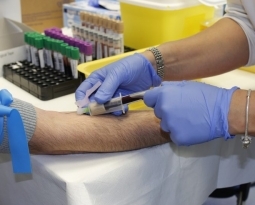Virginia Patent of the Month – August 2021
Hemostasis is the physiological control of bleeding. It’s a complex process that involves platelets, vasculature, coagulation factors, proteins, and inhibitors – and most of our bodies do it automatically. However, disruption of hemostasis can lead to myocardial infarction, stroke, thrombosis, excessive bleeding and more. During cardiac surgeries, there is a clear need for tracking and quantifying potential hemostatic dysfunction for timely treatment. Existing in vitro diagnostics (IVD) use a variety of assays and measurement systems to track hemostatic dysfunction. Hemosonics, LLC has designed a novel hemostasis analyzer which tries to overcome the limitations seen in existing solutions. For instance, existing solutions are restricted to surgical settings and only measure portions of the hemostatic process.
Hemosonics’ solution is more portable and comprehensive. It uses a portable system to determine a wider variety of hemostatic parameters. The patient contributes a blood sample into a cartridge which then directs the sample to separate portions of the cartridge. The different portions allow a variety of analysis. A pressure based vacuum chamber helps to properly administer the sample throughout the cartridge without contaminating the sample or creating unreliable results. The device also offers temperature control as the sample enters the test chambers, through the use of a heat exchanger. Having the temperature match the patient is incredibly important for accurate results. A sick patient may have higher temperatures from fever, or reduced temperatures from large quantities of saline. These temperature changes can impact the body’s ability to coagulate blood, and therefore testing at the relevant temperature is vital. The separate portions of the cartridge allow for 4 tests to run simultaneously. It successfully identifies clot initiation, heparin influence, fibrinogen contribution to clot stiffness, and platelet contribution to clot stiffness. This comprehensive design allows for rapid and accurate analysis using small samples of blood.
Are you developing new technology for an existing application? Did you know your development work could be eligible for the R&D Tax Credit and you can receive up to 14% back on your expenses? Even if your development isn’t successful your work may still qualify for R&D credits (i.e. you don’t need to have a patent to qualify). To find out more, please contact a Swanson Reed R&D Specialist today or check out our free online eligibility test.
Who We Are:
Swanson Reed is one of the U.S.’ largest Specialist R&D tax advisory firms. We manage all facets of the R&D tax credit program, from claim preparation and audit compliance to claim disputes.
Swanson Reed regularly hosts free webinars and provides free IRS CE and CPE credits for CPAs. For more information please visit us at www.swansonreed.com/webinars or contact your usual Swanson Reed representative.

















